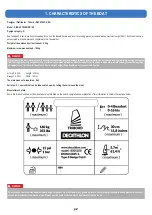
p.3
2. IMPORTANT - SAFETY
Safety equipment on-board
In addition to the buoyancy aid equipment, we recommend that you have a paddle and tow line on-board.
Stability and buoyancy
Any change in the spread of load on-board (for example, adding additional equipment) may significantly affect the stability, trim and performance of the boat;
- air tanks must not be pierced
- breaking waves may significantly affect stability..
Recovery from capsize
See P32
Information linked to the risk of fire or explosion
Inspect your boat for damage prior to each use. If you identify any damage, do not use the product.
Avoid contact of inflatable parts with sharp objects.
Inflate to the optimal pressure indicated on the product under risk of over-inflation and / or explosion.
Never unscrew the valve when the boat is inflated to avoid any risk of rapid ejection of the valve.
Never lean over the valve when you are manipulating it (safety diagram) Never sail in stormy conditions.
Preventing falls overboard and getting back on board
In the event of a fall overboard, you can hold on to the different handles on the hull. We recommend that you re board from the back of the boat, using the handles on
either side of the rudder (1) and the handle on the deck (2) (see Diagram p33)
Attaching mobile parts
We recommend that mobile parts are carefully attached when the boat is underway, using the stowage elastics located at the front of the boat.
Respect for the environmental
Keep informed of local environmental regulations in the area you are sailing and follow the codes of good practice.
We recommend you become familiar with the international regulations on pollution of the marine environment (Marpol) and follow the regulations.
Anchoring, mooring and towing
the handle on the front of the boat, identified by the pictogram enables you to fasten a grapnel-type anchoring device (minimum 2.3 kg) and a towing system.
When towing a second boat, you can attach a second 5S to the back of yours using the handles on the back of the boat, on either side of the transom.
Comment: To anchor safely, find out about anchoring techniques before attempting it.
Summary of Contents for Tribord DINGHY 5S
Page 1: ...p 1 ...
Page 2: ...p 2 ...
Page 15: ...p 13 1 p 13 ...
Page 16: ...p 14 p 14 ...
Page 17: ...p 15 p 15 ...
Page 18: ...p 16 p 16 ...
Page 19: ...p 17 p 17 ...
Page 20: ...p 18 p 18 ...
Page 21: ...p 19 p 19 ...
Page 22: ...p 20 p 20 ...
Page 23: ...p 21 p 21 ...
Page 24: ...p 22 ...
Page 25: ...p 23 p 23 ...
Page 26: ...p 24 p 24 ...
Page 27: ...p 25 p 25 ...
Page 28: ...p 26 p 26 ...
Page 29: ...p 27 p 27 ...
Page 30: ...p 28 1 1 p 28 ...
Page 31: ...p 29 p 29 ...
Page 32: ...p 30 p 30 ...
Page 33: ...p 31 p 31 ...
Page 34: ...p 32 p 32 ...
Page 35: ...p 33 p 33 NOTES ...



































